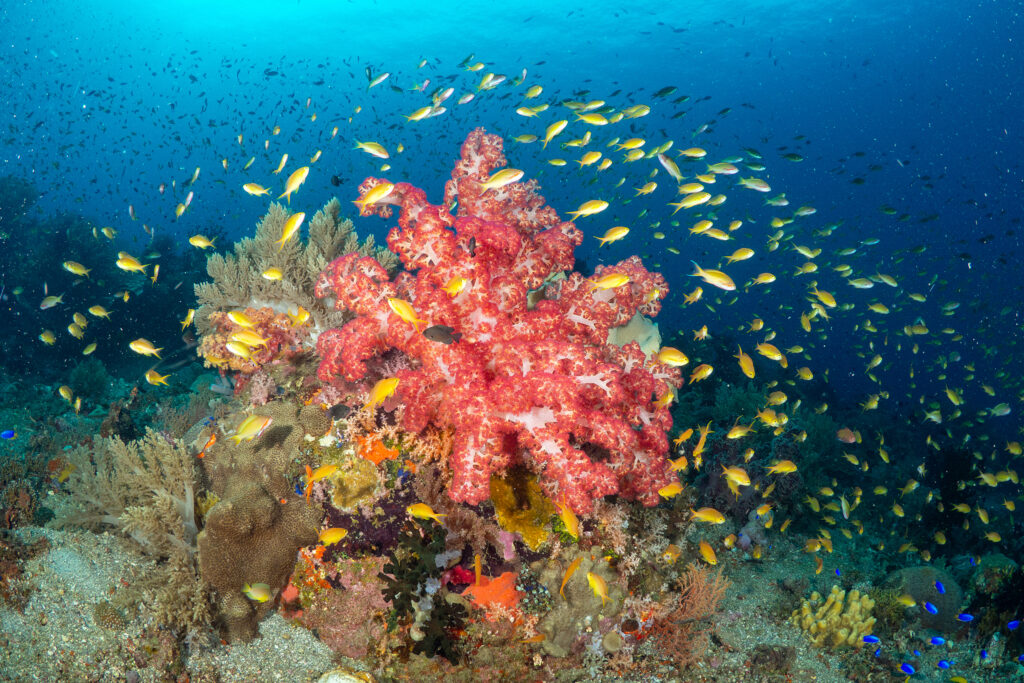By Teresa Tomassoni
Copyright insideclimatenews

The Philippines has designated more than 200 square miles of its coastal waters as a national protected area to safeguard some of the world’s most climate resilient coral reefs.
The new Panaon Island Protected Seascape hosts vibrantly colored and dense coral reefs teeming with schools of juvenile fish, sea turtles, sea anemones and other marine life—a sharp contrast to many of the country’s reefs, which have been steadily declining over the last four decades.
“This is one of the rare places where coral reefs remain in excellent condition, and we now have a chance to keep them that way,” said Von Hernandez, vice president of Oceana Philippines, in a statement. Oceana, an international ocean conservation nonprofit, proposed the new law that created the protected seascape last month.
Since 2023, record-high sea surface temperatures have sparked the most severe global coral bleaching event ever documented, which is currently ongoing, according to NOAA’s Coral Reef Watch. Bleaching occurs when ocean water temperatures become too warm and cause corals to expel the algae living in their tissues, turning their color white.
The federal program, which monitors and predicts sea surface temperature to detect conditions that cause coral bleaching, estimates that more than 80 percent of the planet’s reefs have been impacted in the Atlantic, Indian and Pacific oceans. In the Philippines, corals have not been exempt.
“The reefs would really turn white or dead in certain places because of the temperature change,” said Liza Osorio, senior director for legal and policy campaigns at Oceana in the Philippines. But the area around Panaon Island was an exception. There, in the Southern Leyte province in the Eastern Visayas region of the Philippines, Osorio said, corals have continued to flourish. “These reefs actually survived all these events.”
For some reason, these coral ecosystems have been able to avoid, resist or recover from thermal stress. They may have some sort of genetic adaptations that increase their heat tolerance or they may be sheltered from warmer waters by cold-water currents or other oceanographic processes such as upwelling, the vertical movement of colder, nutrient-rich water from the deep ocean to the surface, Osorio said.
Around the world, there are similar anomalies. Some scientists call them “super reefs.”
Saving Super Reefs
Over the last decade, researchers have become increasingly interested in locating and studying these resilient ecosystems they believe offer the best potential for rebuilding degraded reefs in the future—not only for marine life, but for the people that depend on them, said Emily Darling, director of coral reefs at the Wildlife Conservation Society.
“Identifying and safeguarding reefs that are most likely to survive is just critical to protecting, obviously, biodiversity, food security, coastal livelihoods, coastal protection,” she said.
In 2018, Darling and a group of other coral researchers identified just over 80 coral ecosystems that shared key survival traits. Each spanned at least 200 square miles and faced lower than average predictions of exposure to climate stress—past, present and projected. They were also connected to other reefs.
“Coral connectivity is especially important because coral larvae travel across ocean currents to settle and repopulate damaged reefs,” said Diovanie De Jesus, a marine biologist at Oceana Philippines, in an email.
The researchers’ findings, published in Conservation Letters, a Journal of the Society of Conservation Biology, became largely known as the original “50 Reefs” analysis. Among the reefs identified was Panaon Island.
The island’s reefs have been found to have at least 60 percent live coral cover, according to researchers from Oceana, who surveyed the area on a 21-day expedition in 2020. That’s three times above the national average.
These ecosystems act as underwater fortresses, blunting the force of storm surge that would otherwise erode the island’s coastlines. Their habitat is also deeply intertwined to neighboring ecosystems, from carbon storing seagrass meadows to protective mangrove forests that shelter juvenile fish.
“Species like fish, turtles and whale sharks rely on different habitats—coral reefs, mangroves, seagrass beds, and open waters—for feeding, breeding and migration,” De Jesus said. “When these habitats are linked, it boosts biodiversity, helps damaged areas recover naturally, and strengthens the overall resilience of the ecosystem against climate change and human pressures,” he said.
Community Conservation
Coral reefs are lifelines for fisherfolk who depend on fishing for food or income. “The reef is part of our daily life—it feeds our families,” said Carlito Candidato Jr., president of the Calian Fisherfolk Association in Southern Leyte. For 44 years, Candidato has fished the waters around Panoan Island. “I go out to fish almost everyday, and the reef provides not just fish, but also sea cucumbers and other marine resources that we can sell in the market,” he said in an email.
But over the years, even these super reefs have become vulnerable.
Some have been battered by destructive fishing practices that involve using dynamite to kill or stun fish or cyanide to poison them. “That really damaged the corals badly,” Candidato said.
Others have been stripped by poachers that illegally harvest live coral for sale. At times, plastic pollution and sediment runoff from the island’s mountainous terrain have smothered parts of the reefs, Candidato said. Overfishing and coastal development have also added to the mounting pressures.
For this reason, Candidato said he supported the idea of creating a protected seascape, even if it means some areas are off limits to fishing.
“At first, it might be hard because there may be areas where we are not allowed to catch fish. But if it is managed well, the fish population will recover and, in the long run, there will be more fish even in areas where we are allowed to fish. It’s about short-term sacrifice for long-term benefits.”
The new protected seascape sets aside 16 zones within the seascape that are off-limits to fishing, according to Osario. There are also mixed-use areas where regulated fishing and tourism activities may take place. There are speed limits in place for water vessels using the area in order to ensure the safety of whale sharks and other marine mammals including whales and dolphins that pass through. And using cyanide or dynamite to fish are also strictly prohibited, as is the illegal taking of corals from their natural habitat. “Any violation would result in criminal liabilities,” Osario said.
Now, scientists and advocates from a number of institutions including the Wildlife Conservation Society and Woods Hole Oceanographic Institution are in the process of trying to collect scientific data to support governments around the world in creating more marine protected areas aimed at giving these sorts of climate resilient reefs a fighting chance at surviving more than heat.
“We’ve really got to figure out how to save coral reefs if we’re going to save biodiversity on our planet,” she said.
In June, at the United Nations Ocean Conference in France, Darling helped bring leaders together from 11 countries, including Palau, Panama, Tanzania and Papua New Guinea, to sign a voluntary commitment to protect climate resilient reefs by ensuring their inclusion in national biodiversity, climate and sustainability action plans.
“As a nation on the frontlines of climate change, we know that safeguarding coral reefs is essential not only for biodiversity but for the survival and well-being of our people,” said Palau’s president, Surangel S. Whipps Jr., at the conference. “This commitment reinforces our national priorities and connects them to a shared global vision for resilient ocean futures—one that ensures healthy oceans for future generations,” he said.
By the United Nation’s annual climate summit, COP30, in November, Darling anticipates releasing an updated global map of the world’s most promising super reefs. By COP31 in 2026, she said, she aims to get at least 31 countries onboard by committing to protect them.
Anne Cohen, a tenured scientist at the Woods Hole Oceanographic Institution, is also leading efforts to collect the scientific data needed to establish marine protected areas around thermal tolerant reefs in Maui, the Caribbean and South Pacific. She’s especially interested in creating what she calls “super blue corridors.” These networks of marine protected areas would be strategically designed with the intention of not only safeguarding super reefs, but also the pathways their larvae are expected to pass through as they drift along currents, for example, before they settle on other reefs Cohen hopes they may help reseed and rebuild.
“You can’t put a wall around every single coral reef,” she said. “You have to pick areas very strategically.” And local communities have to be on board and involved in the decision-making around where they are designated, she said. “People have to live. They have to fish, they have to farm, they have to feed their families.”
In August alone, the Philippines not only established the Panaon Island Protected Seascape, but also the Bitaug Marine Protected Area in Siquijor province, which was supported by the Wildlife Conservation Society. That area, too, hosts climate resilient reefs, Darling said. Both of these areas were created in close consultation with local fisherfolk.
Osario, from Oceana Phillipines, said she helped conduct community surveys and town hall meetings in more than 80 villages in Southern Leyte about the Panoan Island proposal, in recent years. “We talked about the benefits of having a national law, how this protection would help improve and have more lasting protection on the reefs,” she said. Overall, she said, “The communities were very supportive.” And they want to help manage the protected seascape.
“Many of us are willing to help patrol the area, report illegal fishing activities, and educate other fisherfolk,” said Candidato. “We live here—we know the sea, and we know who’s doing what. If we are trained and supported, we can be the best protectors of the reef,” he said.



